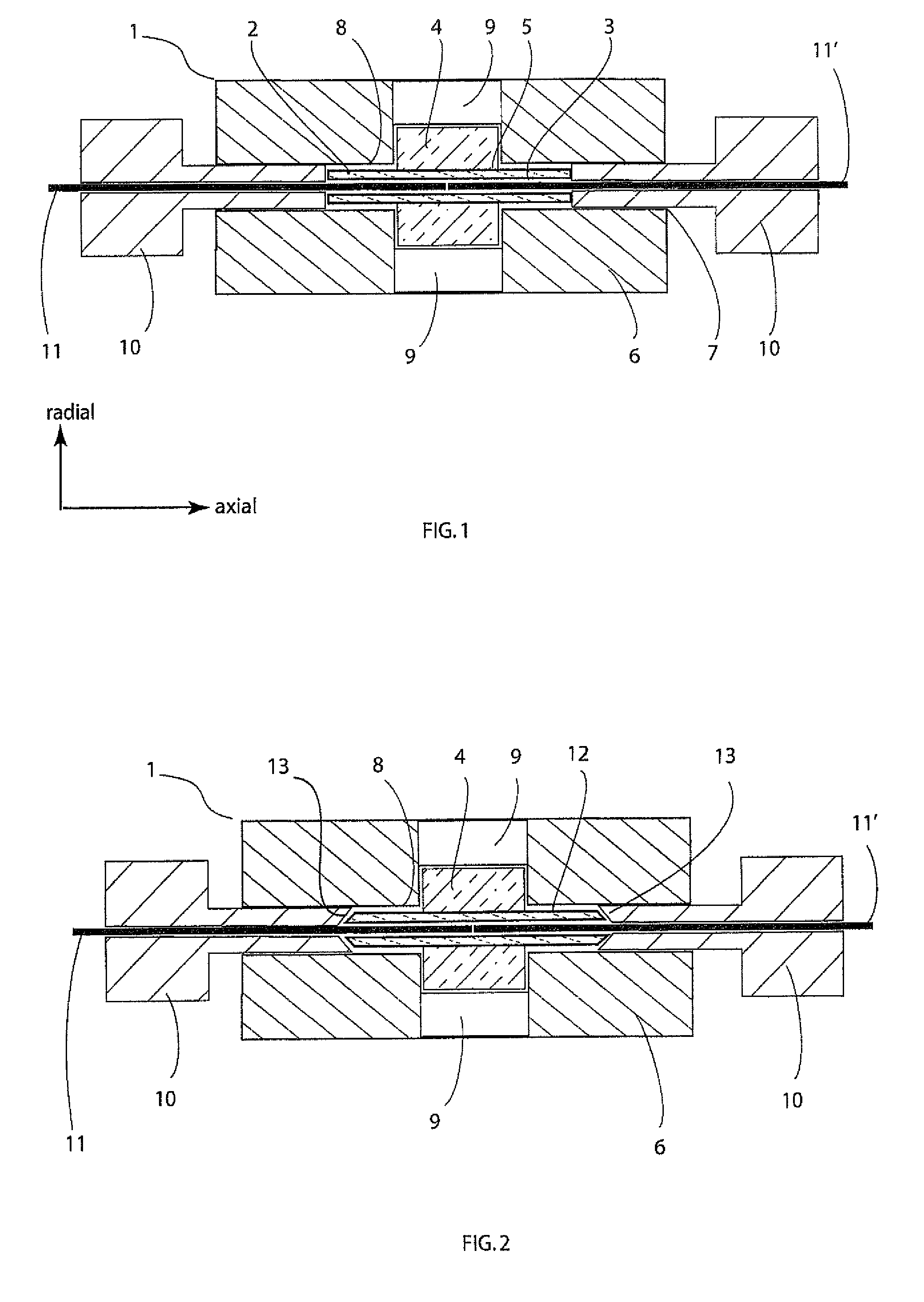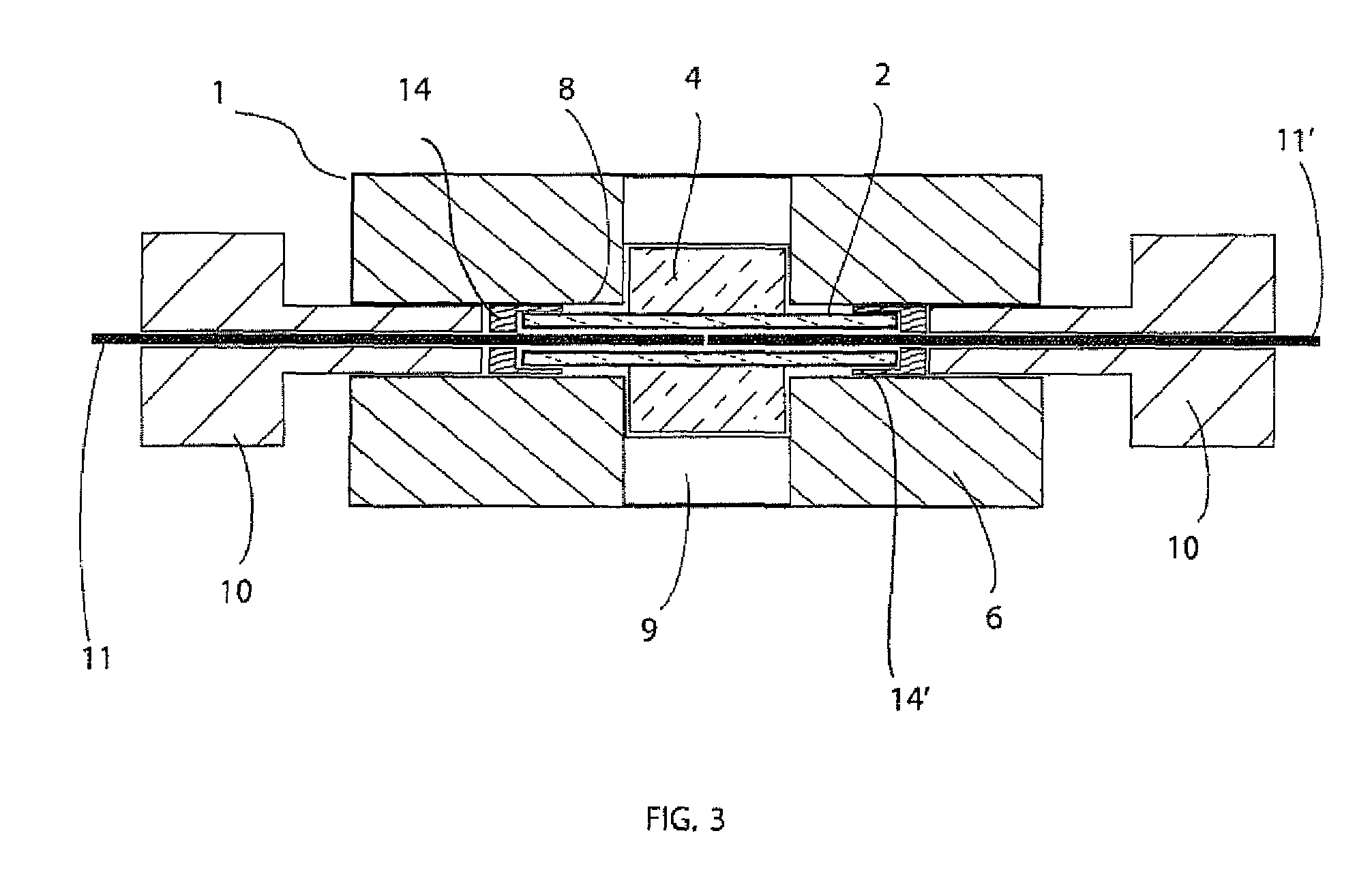Method and apparatus for connecting small diameter tubing
a technology of small diameter tubing and connecting apparatus, which is applied in the direction of hose connection, laboratory glassware, instruments, etc., can solve the problems of difficult to verify the integrity of the coupling, difficult use of high-pressure fittings, and strong friction, so as to avoid the undesirable condition of excess mechanical constraints and high tolerance
- Summary
- Abstract
- Description
- Claims
- Application Information
AI Technical Summary
Benefits of technology
Problems solved by technology
Method used
Image
Examples
example 1
Union Body with Housing
[0104]A union body was fabricated from cut lengths of material. The body was fabricated from cylindrical glass tubing, having an OD of 0.290″ and an ID of 0.063″ which was cut and polished to a length of 0.20″. The core was fabricated from cylindrical FEP tubing, having an OD of 0.062″ and an ID of 0.016″, cut to a length of 0.40″. The core was etched in FluoroEtch solution (sodium in naphthalene) for a period of 1 minute, and then rinsed with distilled water. The core was placed inside the union body and the two were bonded together using Norland Optical Adhesive 83H (a methacrylate based UV curable photopolymer adhesive), following standard manufacturer protocols for UV exposure and polymer curing. Typically the assembly was exposed to UV light from a low wattage UV lamp for 30-60 minutes, and allowed to cure overnight in an oven at approx. 100° C. The union body had the geometry shown in FIG. 5a.
[0105]After curing, the union body was placed inside a stainl...
example 2
Opto-Electronic Detection of Union
[0107]As shown in FIG. 14, light from a laser diode 27 (670 nm, 4 mW) was passed though a focusing lens 28 and an optical density filter 29 (OD 3) yielding an elliptically focused beam having the approximate dimensions of 1.0×0.4 mm at the focal plane of the lens. A union housing body 53 (without the housing as in FIG. 22), having a core fabricated from 0.016″ I.D.×0.062″ O.D. FEP tubing, and a union housing body made from clear, square polymethylmethacrylate (PMMA) polymer having a cylindrical bore 0.063″ I.D.×0.150″ long at its center. Since this was a non-housing embodiment, the flat ended compression nuts 10 threaded directly into the clear union housing-body. These fittings had a terminal OD of 0.062″ and could directly compress the core material by extending into the 0.063″ bore of the union body. The union body was placed in this focal plane of the lens, with the long axis of the union parallel and coincident to the 1 mm axis of the beam. A p...
example 3
Coupling of Optical Fibers
[0114]The unique properties of the invention permit high efficiency coupling of light from one optical fiber to another. When the elastomer core is compressed, its I.D. reduces to the O.D. of the fibers being connected. Furthermore, since the core is one continuous ID, the coaxial alignment of the two fibers will be excellent, and essentially self-aligning.
[0115]In this example a union of the cartridge design (as in FIGS. 4a-c) was used to connect two pieces of small core diameter single mode optical fiber. The apparatus is shown in FIG. 16.
[0116]Light from a laser diode 26 (670 nm, 4 mW) was launched into a first single mode optical fiber 36 (3.2 μm O.D. core, 125 μm O.D. cladding, 250 μm O.D. polymer jacket, 488 nm design wavelength, cleaved at both ends to 20 cm length) using a fiber coupling stage with a ball lens (Newport Corporation). The free end of fiber 36 was inserted into the union assembly 1, having a 0.010″ I.D.×0.062″ O.D.×0.280″ long FEP elas...
PUM
| Property | Measurement | Unit |
|---|---|---|
| pressure | aaaaa | aaaaa |
| pressure | aaaaa | aaaaa |
| pressure | aaaaa | aaaaa |
Abstract
Description
Claims
Application Information
 Login to View More
Login to View More - R&D
- Intellectual Property
- Life Sciences
- Materials
- Tech Scout
- Unparalleled Data Quality
- Higher Quality Content
- 60% Fewer Hallucinations
Browse by: Latest US Patents, China's latest patents, Technical Efficacy Thesaurus, Application Domain, Technology Topic, Popular Technical Reports.
© 2025 PatSnap. All rights reserved.Legal|Privacy policy|Modern Slavery Act Transparency Statement|Sitemap|About US| Contact US: help@patsnap.com



